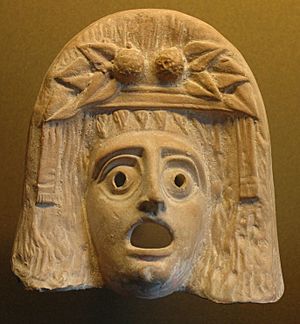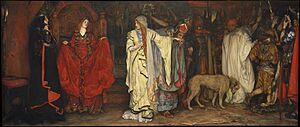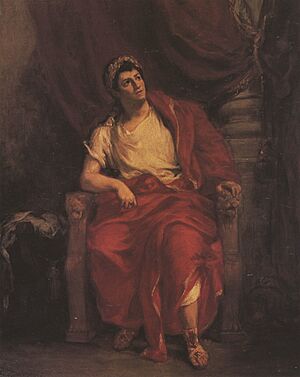Tragedy facts for kids
Tragedy is a type of play or story that focuses on human suffering. It usually involves terrible or sad events happening to a main character, often called a "tragic hero." The goal of tragedy is to make the audience feel strong emotions like pity and fear. After experiencing these feelings, the audience might feel a sense of relief or emotional cleansing, which is called "catharsis."
This type of drama started in ancient Greece about 2,500 years ago. Famous Greek writers like Aeschylus, Sophocles, and Euripides wrote many tragedies, but only a small number of their plays still exist today. Later, Roman writers like Seneca also wrote tragedies. Over time, tragedy continued to be important in different cultures, with famous playwrights like William Shakespeare, Jean Racine, and Henrik Ibsen creating their own versions. Many thinkers and philosophers have also studied and discussed what makes a tragedy.
In the past, tragedy was often seen as different from other types of plays, like comedy. Comedy usually has a happy ending, while tragedy focuses on serious and often sad events.
Contents
What Does "Tragedy" Mean?
The word "tragedy" comes from the ancient Greek word tragōidia, which means "goat song." Scholars think this name might come from a time when a goat was given as a prize in a singing or dancing contest, or when a chorus danced around a goat before it was sacrificed in a ritual. Another idea is that it came from "grape harvest song," because these plays first appeared during grape harvest festivals.
Around 335 BCE, a famous Greek thinker named Aristotle tried to explain where tragedy came from. He believed it grew out of improvisations by the leader of a Greek chorus, who would sing and dance hymns to Dionysus, the god of wine.
Aristotle also gave a famous definition of tragedy:
Tragedy is a play about an important and complete event, with beautiful language. It is acted out, not just told, and through pity and fear, it helps us release these emotions.
Some people disagree with the "goat song" idea, pointing out differences in how choruses danced. Another idea is that tragedy came from ancient ceremonies related to farming and burials.
Tragedy in Ancient Greece

Ancient Greek tragedy is the oldest type of tragedy we still have today. It was a big part of the theater in the city of Athens. It started in the 6th century BCE and became very popular in the 5th century BCE.
Greek tragedies were performed once a year in late March or early April, as part of a religious festival honoring Dionysus. It was a competition where three playwrights would present their plays on three different days. Each writer would show three tragedies and one funny play called a satyr play. Sometimes, the four plays would tell connected stories. We only have one complete set of three tragedies, called the Oresteia by Aeschylus.
Greek theaters were outdoors, often built into the side of a hill. Performances probably lasted most of the day. About 12,000 people could fit in the Theatre of Dionysus in Athens. All the songs in the plays were sung with music, and actors also sang some of their lines. All actors were men and wore masks. The chorus would dance as they sang, though we don't know exactly what their dance steps looked like.
Greek tragedies used special stage devices. One was the ekkyklêma, a platform that could be rolled out to show something that happened offstage, often a violent event. This allowed the audience to see the results of the action, even if they didn't see it happen. Another device was the mechane, a crane that could lift an actor to make them appear like a god flying onto the stage. This gave us the famous phrase "deus ex machina" (god out of a machine), which means a surprising and unexpected event that suddenly solves a problem in a story.
Roman Tragedy
After the Roman Republic grew and took over Greek lands, Romans discovered Greek tragedy. Theater then spread across Europe and the Mediterranean. While Greek tragedies were still performed, Roman writers like Livius Andronicus and Gnaeus Naevius started writing their own Roman tragedies around 240 BCE. Sadly, no complete early Roman tragedies have survived.
Later, during the Roman Empire, we have tragedies from an unknown writer and from the philosopher Seneca. Nine of Seneca's tragedies still exist. They were often based on Greek stories, like his play Phaedra, which was based on Euripides' Hippolytus. Seneca's plays were probably meant to be read aloud at fancy gatherings, not always performed. They often had long speeches, focused on morals, and described terrible events in detail. They also featured ghosts and witches.
Tragedy in the Renaissance
For a long time, from the Middle Ages until the 16th century, classical Greek drama was mostly forgotten in Western Europe. Plays during this time were often religious stories or comedies.
However, in Italy, people became interested in Roman tragedies again, especially Seneca's plays. The first non-religious tragedy written since Roman times was Eccerinis in 1315. It used a historical story to warn about danger. Later, in 1515, Gian Giorgio Trissino wrote Sophonisba, which was one of the first tragedies written in Italian. It followed classical rules closely.
Around 1500, printed copies of plays by Greek writers like Sophocles and Euripides, and Roman writers like Seneca, became available. This led to many scholars and poets translating and adapting these tragedies. Seneca's plays, with their ghosts and dramatic speeches, had a big impact on many tragedies written during this time.
British Tragedies
In England, the most famous tragedies were written by William Shakespeare and his friends during the Elizabethan era. Shakespeare's tragedies include:
Another famous writer of tragedies from Shakespeare's time was Christopher Marlowe, known for plays like The Tragical History of Doctor Faustus. John Webster also wrote well-known tragedies such as The Duchess of Malfi.
Domestic Tragedy
Domestic tragedies are plays where the main characters are ordinary people, like middle-class or working-class individuals, instead of kings or nobles. This was a big change from classical tragedies, where the downfall of a king was a huge event for a whole country.
The Greek thinker Aristotle believed that tragedies should only be about great people, because their fall would be more powerful. But domestic tragedy broke this rule. It showed that the struggles of everyday people could also be tragic. This type of tragedy led to modern tragedies that explore themes like poverty, debt, crime, and loneliness.
Some early domestic tragedies include Arden of Faversham (1592) and A Yorkshire Tragedy (1608). This style of tragedy helped shape the works of modern playwrights like Arthur Miller and Henrik Ibsen.
Opera as Tragedy
At the same time as Shakespeare, a new way to bring back tragedy appeared in Italy: opera. Early opera composers like Jacopo Peri tried to recreate ancient Greek tragedies, believing they were sung throughout. This led to the new musical style of opera. In France, tragic operas were even called tragédie en musique ("tragedy in music"). Later composers like Richard Wagner also aimed to combine all arts, like in Greek tragedy, into one "integrated work of art."
Neo-classical Tragedy
In the 17th century, Pierre Corneille was a very successful French tragedy writer. His plays, like Le Cid, sometimes had happy endings, which was unusual for tragedies. Corneille believed that plays should feature noble characters and that tragedies should deal with important matters of state, like wars. He also thought plays should not show evil being rewarded.
Later, Jean Racine became very famous for his tragedies. He was inspired by Greek myths and writers like Euripides and Seneca. Racine's plays focused on intense emotional conflicts and difficult choices faced by a small group of noble characters. His plays were known for showing strong feelings and passions.
Modern Tragedy
In modern times, the idea of tragedy has become less strict. A major change is that tragedies can now be about ordinary people, not just those in power. Playwright Arthur Miller argued that tragedy can show the struggles of common people in their everyday lives.
Some critics, like George Steiner, even wonder if true tragedy, like the ancient Greek kind, still exists today. He suggested that Shakespeare's plays, while rich and complex, are different from the "absolute tragic model" of ancient Greece.
However, many books and plays continue to be written in the tradition of tragedy, exploring sad and difficult themes. Examples include The Road and The Fault in Our Stars.
What Makes a Tragedy?
Defining tragedy can be tricky because there are many different ideas about it. Some definitions focus on what tragedy expresses about the world, while others look at the parts that make up a tragic play.
Aristotle's Ideas
Aristotle believed that tragedy is serious and involves a great person who experiences a sudden change in their luck, often from good to bad. He thought this change makes the audience feel pity and fear, leading to an emotional cleansing (catharsis).
According to Aristotle, the hero's downfall is usually caused by a mistake or a flaw, not by being completely evil. This mistake is called hamartia. The hero's fall is an expected but unplanned result of their own actions. If a character's downfall is caused by something outside their control, like fate, Aristotle called it a "misadventure," not a true tragedy.
Also, the tragic hero might gain some important understanding or realization about human life or destiny, which Aristotle called anagnorisis. This is like "knowing again" or "realizing something new."
Aristotle said that a tragedy should be "an imitation of an action that is admirable, complete, and has importance; in beautiful language; performed by actors, not just told; and through pity and fear, it cleanses these emotions."
Based on Aristotle, there are four types of tragedy:
- Complex: Involves a sudden change in fortune and a discovery.
- Suffering: Focuses on intense pain, like in stories of Greek heroes.
- Character: Deals with a person's moral or ethical nature.
- Spectacle: Has a horror-like theme, meant to shock the audience.
Hegel's Ideas
Another philosopher, G.W.F. Hegel, had his own ideas about tragedy. He believed that in ancient Greek tragedy, the conflict came from two equally right ethical forces clashing. For example, a character might have to choose between two good but opposing duties, leading to a tragic outcome.
However, Hegel thought that in later tragedies, like Shakespeare's, the conflict was more about the individual character's inner struggles and passions. He felt that modern characters often act based on their own desires, and their strong emotions can lead to their downfall, even if it's self-destructive. For example, he said that in Hamlet, death seems to come by accident, but Hamlet's inner sadness and disgust had already consumed him.
See also
 In Spanish: Tragedia para niños
In Spanish: Tragedia para niños
- Classicism
- Revenge tragedy



